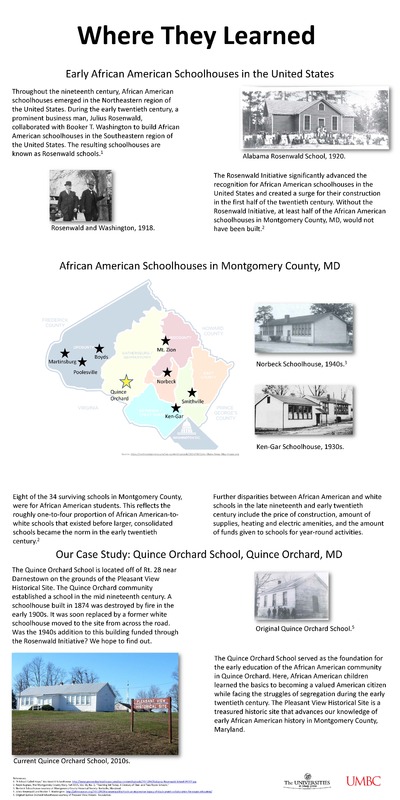Where They Learned
Early African American Schoolhouses in the United States
Throughout the nineteenth century, African American schoolhouses emerged in the Northeastern region of the United States. During the early twentieth century, a prominent business man, Julius Rosenwald, collaborated with Booker T. Washington to build African American schoolhouses in the Southeastern region of the United States. The resulting schoolhouses are known as Rosenwald schools.
The Rosenwald Initiative significantly advanced the recognition for African American schoolhouses in the United States and created a surge for their construction in the first half of the twentieth century. Without the Rosenwald Initiative, at least half of the African American schoolhouses in Montgomery County, MD, would not have been built.
African American Schoolhouses in Montgomery County, MD
Eight of the 34 surviving schools in Montgomery County, were for African American students. This reflects the roughly one-to-four proportion of African American-to-white schools that existed before larger, consolidated schools became the norm in the early twentieth century. Further disparities between African American and white schools in the late nineteenth and early twentieth century include the price of construction, amount of supplies, heating and electric amenities, and the amount of funds given to schools for year-round activities.
Our Case Study: Quince Orchard School, Quince Orchard, MD
The Quince Orchard School is located off of Rt. 28 near Darnestown on the grounds of the Pleasant View Historical Site. The Quince Orchard community established a school in the mid nineteenth century. A schoolhouse built in 1874 was destroyed by fire in the early 1900s. It was soon replaced by a former white schoolhouse moved to the site from across the road. Was the 1940s addition to this building funded through the Rosenwald Initiative? We hope to find out.
The Quince Orchard School served as the foundation for the early education of the African American community in Quince Orchard. Here, African American children learned the basics to becoming a valued American citizen while facing the struggles of segregation during the early twentieth century. The Pleasant View Historical Site is a treasured historic site that advances our knowledge of early African American history in Montgomery County, Maryland.
